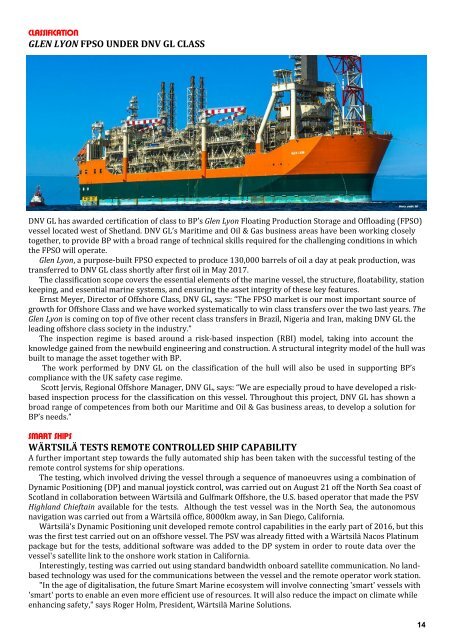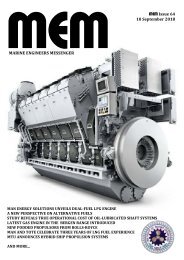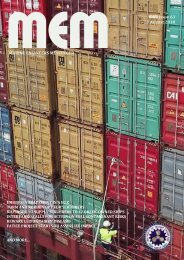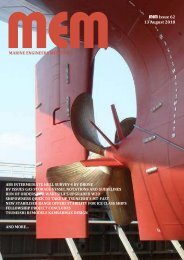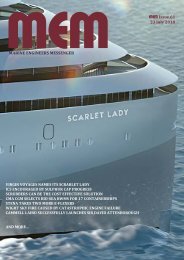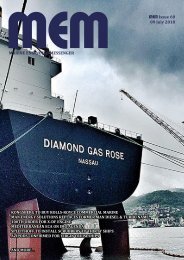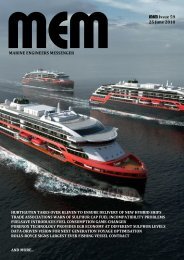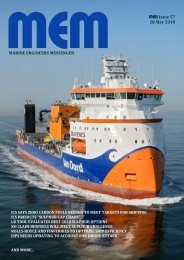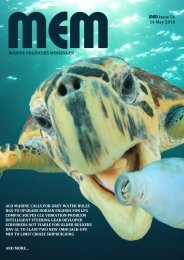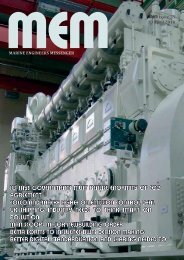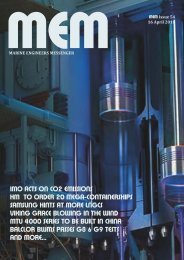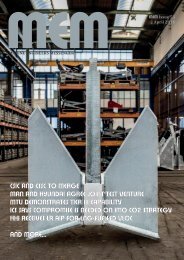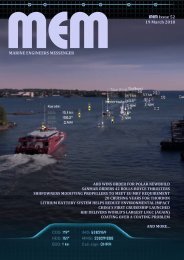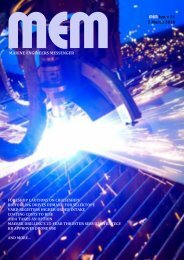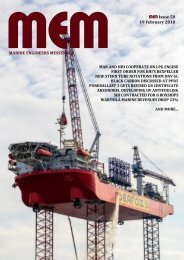MEM39
Marine Engineers Messenger, Volume 2, Issue 39
Marine Engineers Messenger, Volume 2, Issue 39
You also want an ePaper? Increase the reach of your titles
YUMPU automatically turns print PDFs into web optimized ePapers that Google loves.
CLASSIFICATION<br />
GLEN LYON FPSO UNDER DNV GL CLASS<br />
DNV GL has awarded certification of class to BP’s Glen Lyon Floating Production Storage and Offloading (FPSO)<br />
vessel located west of Shetland. DNV GL’s Maritime and Oil & Gas business areas have been working closely<br />
together, to provide BP with a broad range of technical skills required for the challenging conditions in which<br />
the FPSO will operate.<br />
Glen Lyon, a purpose-built FPSO expected to produce 130,000 barrels of oil a day at peak production, was<br />
transferred to DNV GL class shortly after first oil in May 2017.<br />
The classification scope covers the essential elements of the marine vessel, the structure, floatability, station<br />
keeping, and essential marine systems, and ensuring the asset integrity of these key features.<br />
Ernst Meyer, Director of Offshore Class, DNV GL, says: “The FPSO market is our most important source of<br />
growth for Offshore Class and we have worked systematically to win class transfers over the two last years. The<br />
Glen Lyon is coming on top of five other recent class transfers in Brazil, Nigeria and Iran, making DNV GL the<br />
leading offshore class society in the industry.”<br />
The inspection regime is based around a risk-based inspection (RBI) model, taking into account the<br />
knowledge gained from the newbuild engineering and construction. A structural integrity model of the hull was<br />
built to manage the asset together with BP.<br />
The work performed by DNV GL on the classification of the hull will also be used in supporting BP’s<br />
compliance with the UK safety case regime.<br />
Scott Jervis, Regional Offshore Manager, DNV GL, says: “We are especially proud to have developed a riskbased<br />
inspection process for the classification on this vessel. Throughout this project, DNV GL has shown a<br />
broad range of competences from both our Maritime and Oil & Gas business areas, to develop a solution for<br />
BP’s needs.”<br />
SMART SHIPS<br />
WÄRTSILÄ TESTS REMOTE CONTROLLED SHIP CAPABILITY<br />
A further important step towards the fully automated ship has been taken with the successful testing of the<br />
remote control systems for ship operations.<br />
The testing, which involved driving the vessel through a sequence of manoeuvres using a combination of<br />
Dynamic Positioning (DP) and manual joystick control, was carried out on August 21 off the North Sea coast of<br />
Scotland in collaboration between Wärtsilä and Gulfmark Offshore, the U.S. based operator that made the PSV<br />
Highland Chieftain available for the tests. Although the test vessel was in the North Sea, the autonomous<br />
navigation was carried out from a Wärtsilä office, 8000km away, in San Diego, California.<br />
Wärtsilä's Dynamic Positioning unit developed remote control capabilities in the early part of 2016, but this<br />
was the first test carried out on an offshore vessel. The PSV was already fitted with a Wärtsilä Nacos Platinum<br />
package but for the tests, additional software was added to the DP system in order to route data over the<br />
vessel's satellite link to the onshore work station in California.<br />
Interestingly, testing was carried out using standard bandwidth onboard satellite communication. No landbased<br />
technology was used for the communications between the vessel and the remote operator work station.<br />
"In the age of digitalisation, the future Smart Marine ecosystem will involve connecting 'smart' vessels with<br />
'smart' ports to enable an even more efficient use of resources. It will also reduce the impact on climate while<br />
enhancing safety," says Roger Holm, President, Wärtsilä Marine Solutions.<br />
14


